Australian Jazz – An Arrangement Of Many Parts
John McBeath
January 2010

Wangaratta Jazz Festival 2009
On a commercial level Japan and Australia maintain a highly active relationship – Japan remains Australia's largest export market – but in cultural matters our two countries have quite a deal of catching up to do. A great gap exists in Australia's general knowledge of the arts in Japan, and I suspect the reverse is also true. In this article I will try to introduce a Japanese reader to one of the flourishing, but minority art forms in the "land down under": Australian jazz in its many styles.
Following America's lead, The Jazz Age arrived in Australia in the 1920s and influenced popular music for the next twenty years. Most houses had a gramophone or piano and the sounds of ragtime or songs from the Al Jolson film "The Jazz Singer," and later those of pianist Fats Waller and a host of others could be heard in homes across the country. By the late thirties and for most of the forties big bands had arrived; Benny Goodman, Gene Krupa, Woody Herman, Glen Miller and many other US bands were copied and imitated in Australia where people jived and jitterbugged on dance-floors to the big band swing.
At the same time an original form of jazz named 'Traditional' ('Trad') or 'Dixieland' ('Dixie') underwent a strong resurgence, usually with a frontline of trumpet, trombone and clarinet. In Australia, Melbourne became headquarters for the trad scene with pianist Graeme Bell (1914 - ) forming the Graeme Bell Jazz Gang in 1941 and in 1943 the Dixieland Jazz Band. They began recording and in 1947 they were the first Australian jazz band to tour Europe, performing to great acclaim in the UK in 1948. Even back then the music had an Australian originality which Bell described as "a happy Aussie outdoor feel." They released a version of Louis Armstrong's famous piece "When The Saints Go Marching In," which achieved great popularity in the early fifties. At the same time there were Trad and big bands playing in every large city in Australia and also across the Tasman Sea in New Zealand.
By the mid fifties though, the big band era was over, pop music had moved on, Elvis Presley was sweeping the charts, and the economics of keeping an 18 piece band together saw the start of their demise. They certainly haven't disappeared completely though; there are a number of excellent big bands still playing and drawing audiences today in Australia, usually playing their own advanced compositions and arrangements. There are also signs of a return of the swing movement for a new, young audience. By the sixties, Trad, although still played, was attracting diminished audiences. Those audiences are looking mostly elderly today, as are many of the practitioners, and it will be interesting to see whether Trad can attract the younger followers it will need to survive into future decades. In the meantime trumpeters James Morrison, Bob Barnard, and Peter Gaudion, drummer Allan Browne, violinist George Washingmachine, and many others continue along the Trad and Mainstream paths.
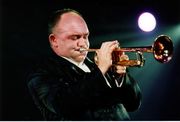
James Morrison
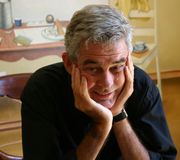
Allan Browne
The earliest type of jazz, what we now call the Blues, derived from work songs in Southern cotton fields in the US, and apart from the Blues surviving more or less in its original form, it also appears embedded in many other jazz styles. Interestingly Blues and Roots – meaning basic, foundational, including Soul and Gospel – music is very much alive and well, attracting good and youthful crowds to performances, especially at numerous Blues Festivals across the country. Several Australian Blues artists have won international acclaim: Sri-Lankan born, Melbourne based young vocalist Andrea Marr won praise at the International Blues Challenge in Memphis; Hat Fitz & Cara Robinson belt out Delta Blues with Australian influences on European tours, and the Sydney trio "Backsliders" have wailed their harmonica-led blues around the world for twenty years now. In the Roots music Soul genre, vocalist Tina Harrod is outstanding and in Gospel & Soul, Adelaide's Charmaine Jones is one of those at the forefront.
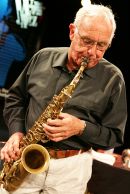
Don Burrows
Photo by Cheryl Browne
One of the most important events in jazz during the last century was in the late forties when US saxophonist Charlie "Bird" Parker discovered and applied extended harmonies, building additional notes on to the underlying basic chords used up until then, and constructing new melodies to fit. From there on into the fifties he and others founded the be-bop movement, so called because many of their musical phrases ended with a be-bop sound. Again Australian groups were quick to follow and by the sixties the most advanced of the local bands were playing bop compositions from the US and improvising very much in the same way as American players. It was around this time that some of the Australian avant garde began to experiment with unstructured playing, a kind of instantaneous composition around tonal centres, and sometimes moving out of rhythm altogether in a genre known as "Free Jazz." This scenario continued and developed right through into the eighties, and saw the gradual emergence of uniquely individual performers. Local bop players began to play more of their own compositions, to experiment more, and to find more original ways to express and progress their music. Saxophonists Bernie McGann, Brian Brown and Don Burrows were pioneers, as were pianists Bob Sedergreen and Serge Ermol, drummer John Pochee and the late vibraphonist John Sangster.
During the eighties and the last decade of the 20th century it was obvious that contemporary Australian jazz had truly come into its own. Sydney and Melbourne led the way, with Brisbane, Perth and Adelaide also producing talented and original musicians, partly due to the introduction of Jazz Studies courses in universities in all states. English jazz critic Stuart Nicholson in 2005 published his book "Is Jazz Dead? (Or Has It Moved To a New Address)" arguing that global jazz had become local, relying less and less on American models and using more locally inspired geographical and cultural elements. He identified some examples including the Nordic sound of Scandinavian artists, European jazz with its many classical influences, and original Australian developments.

Mike Nock
Photo by Cheryl Browne
One of the larger groups to embody a uniquely Australian sound was "Ten Part Invention" using first class soloists and original compositions by their late pianist Roger Frampton. Pianist Mike Nock returned to Sydney in 1985 after twenty-five years playing in the US and immediately began forming various sized groups and mentoring many younger players. Saxophonist Dale Barlow studied in New York in the early eighties and subsequently played with a number of top flight Americans: Dizzy Gillespie, Art Blakey and Sonny Stitt, amongst others before returning home. Another expatriate, pianist Paul Grabowsky came back to Australia in the mid-eighties after six years living and playing in Europe, and soon formed a quartet, "The Wizards of Oz" with Barlow on saxophone, later expanding to a sextet, "The Groovematics," who appeared five times weekly on a live TV show over three years.
During the seventies and eighties yet another genre began to flourish: Jazz Rock, a fusion style which used elements of Rock 'n' Roll, especially rhythmic components, blended with influences from jazz, following Miles Davis's landmark recording in this style, "Bitches Brew" from the early seventies. Two groups stood out in this context: "Crossfire" and "D.I.G (Directions in Groove)"
By the end of the twentieth century Australian Jazz in all its many manifestations had become truly original, with the stamp of a hard-to-define but recognisable Australian-made product. Buoyed by waves of graduates from Jazz Studies courses in every state, as the bop pioneers began to age, ever-new approaches were being tried by youthful, astonishingly talented players. Electronica was introduced utilising laptop computers, and a wide range of digital equipment extended the tonal range of not just guitars, but all the other instruments. "Free Jazz" from the sixties has been rediscovered and progressed to another level in experimentation whilst contemporary small and large groups, vocalists and big bands continue to evolve, perform and record.
In the first decade of the 21st century virtuosi arrived, such as saxophonists Jamie Oehlers and Julien Wilson, along with trumpeters Scott Tinkler and Phil Slater, pianists Barney McAll, Marc Hannaford, and Aaron Choulai, vocalists Katie Noonan and Kristin Berardi, drummer Simon Barker, and guitarists Stephen Magnusson and James Muller.
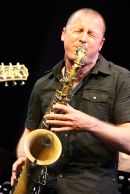
Jamie Oehlers
Photo by Cheryl Browne
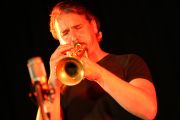
Scott Tinkler
Photo by Cheryl Browne
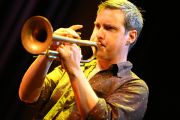
Phil Slater
Photo by Cheryl Browne
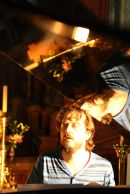
Barney McAll
Photo by Cheryl Browne
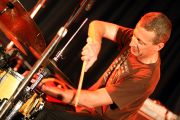
Simon Barker
Photo by Cheryl Browne
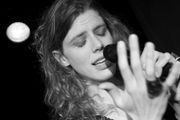
Kristin Berardi
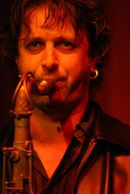
Julien Wilson

Cover of Katie Noonan's
recent blackbird album
These are only a few important names from the huge selection of talented performers producing a large body of works. From the global metropolises of Sydney and Melbourne, across the red, arid interior to the lush tropical north, Australian jazz is as diverse as the country itself.
About the author
John McBeath has been jazz critic for the national daily newspaper "The Australian," for five years, and for a similar time at "The Advertiser," the daily paper in his home base, Adelaide, South Australia. He's been listening critically to jazz for over fifty years, and for a period of fifteen years he worked in radio in three states, often presenting jazz programs. Before that he learned to play piano, alto sax and clarinet and studied music theory. John is happily married to Mary who shares his passion for jazz, and who often sub edits his writing. When friends ask if he still plays the piano, John answers: "Not in public. These days I just criticise other people's playing."
Major jazz festivals in Australia
Victoria
- Wangaratta Jazz Festival
- Melbourne International Jazz Festival
- Stonnington Jazz Festival
- Mildura Jazz Festival
- Melbourne Jazz Fringe Festival
New South Wales
Queensland
Western Australia
Major jazz venues in Australia
Sydney
Melbourne
- Bennett's Lane
- Club 303
- The Paris Cat
Brisbane
Adelaide
Perth
Recent Australian Jazz Performances in Japan
- Australian Jazz Night at Tokyo Jazz Festival 2009
- Sapporo City Jazz
- Alister Spence Trio Japan Tour
- Makoto Kuriya presents - Stars of Australia
- Makoto Kuriya Trio featuring Simon Barker
- Japan-Australia Jazz Orchestra (JAJO) hit Tokyo Jazz Festival 2006
- Japan-Australia Jazz Orchestra for the 2006 Australia-Japan Year of Exchange
